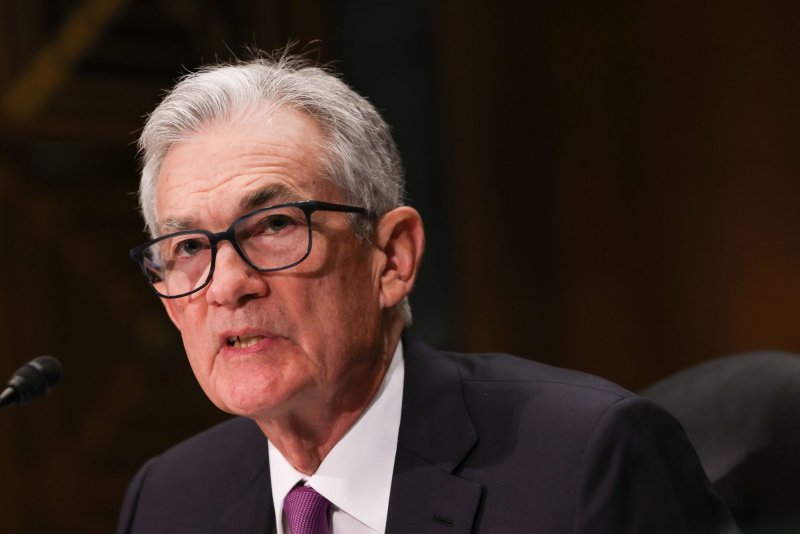Fed Chair Jerome Powell said Wednesday the Fed decided to leave interest rates unchanged. He said during a press conference that Inflation has eased substantially to 3% from a high of 7%. He said data drives interest rate decisions and he has not made any decision about any future meeting on interest rates. File Photo by Jemal Countess/UPI |
License PhotoJuly 31 (UPI) — The Federal Reserve Wednesday decided to leave interest rates unchanged at 5.25 to 5.50% as expected by economists. Fed Chair Jerome Powell said inflation has eased substantially toward the target of 2%.
“We are maintaining our restrictive monetary policy in order to keep demand in line with supply and reduce inflationary pressures,” Powell said during a Wednesday press conference.
Powell told reporters the Federal Reserve remains focused on achieving the dual goals of “maximum employment and stable prices for the American people.”
During his press conference he said the U.S. economy has made considerable progress in the past two years.
“The labor market has come into better balance and the unemployment rate remains low. Inflation has eased substantially from a peak of 7% to 2.5%,” Powell said.
He said the Fed remained committed to returning inflation to the 2% goal “in support of a strong economy that benefits everyone.”
Powell said the Fed decided to leave interest rates unchanged and to continue to reduce the central bank’s security holdings.
Powell said recent economic indicators show the economy has continued to expand “at a solid pace.”
U.S. Gross Domestic Product moderated to 2.1% in the first half of the year, Powell said. That’s down from 3.1% last year.
He said interest rate cuts won’t happen until the Fed is confident, based on the data, that inflation is returning to 2%.
Powell said as the Fed watches economic data to determine whether or not to cut interest rates, inflation readings “have added to our confidence and more data would further strengthen that confidence.
“We know that reducing policy restraint too soon or too much could result in the reversal of the progress we have seen on inflation,” Powell cautioned.
He said as the economy evolves the Fed’s monetary policy will adjust “in order to best promote our maximum employment and price stability goals.”
The Fed, Powell said, is prepared to respond to either a weakening of the labor market or inflation falling more quickly than anticipated.
Regarding possible interest rate cuts, Powell said he hasn’t made any decision about any future meeting because he doesn’t know what the data will reveal or how that will affect policy.
Powell summed up the current economic situation by saying “Inflation has come down much closer to our goal, and that’s happened while unemployment has remained low. We’re very tightly focused on using our tools to try to foster that state of affairs continuing.”
According to the CME FedWatch Tool, economists think chances the Fed will cut rates in September are 85%.
According to reporting by the New York Times, the Fed’s decision on a rate cut will come on Sept. 18, when policymakers next meet. Investors widely expect a cut to come then.
The Federal Reserve seeks to curb inflation while sustaining a strong labor market. The central bank’s inflation target is 2% and interest rates have stayed high for one year in the fight against inflation.
“For a long time, since inflation arrived, it’s been right to mainly focus on inflation. But now that inflation has come down and the labor market has indeed cooled off, we’re going to be looking at both mandates. They’re in much better balance,” Powell said at an Economic Club meeting in Washington.
The rate of inflation has dropped substantially from a peak of over 8% in 2022 down to 3% for the month of June.
On July 15 Fed Chair Jerome Powell said he would not wait until inflation is down to 2% to begin interest rate cuts.
“The implication of that is that if you wait until inflation gets all the way down to 2%, you’ve probably waited too long, because the tightening that you’re doing, or the level of tightness that you have, is still having effects which will probably drive inflation below 2%,” Powell said.
The U.S. economy rose sharply in the second quarter, with GDP up a higher-than-expected 2.8%, according to the U.S. Bureau of Economic Analysis.
Payroll company ADP’s National Employment Report said Wednesday that according to its records private sector job creation fell to 122,000 jobs in July while annual pay for workers was up 4.8% over 2023.
The U.S. Bureau of Labor Statistics will release its July jobs report Friday.
The U.S. unemployment rate rose to 4.1% in June.

